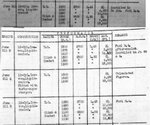wuzak
Captain
I don't know where you found this but the english wiki has a cruise speed of 265mpg for the B.IV.
Sorry, info for the Me 210 I got from Wiki.
As you are no doubt aware, there are many different possible cruise speeds. From most economical to maximum (with maximum continuous power). From memory the B.IV could cruise at 330mph maximum continuous. I don't have all my references with me, so I don't know if I can find a source.

